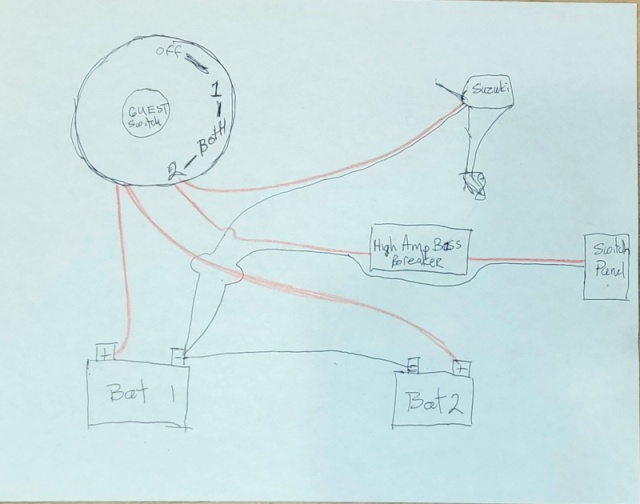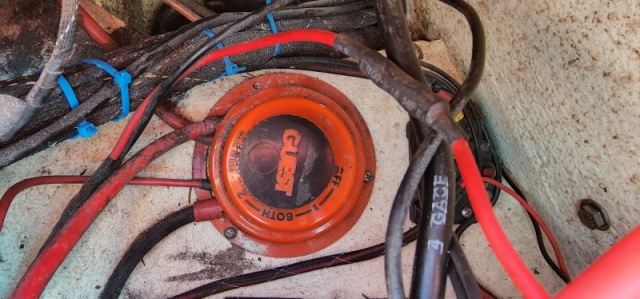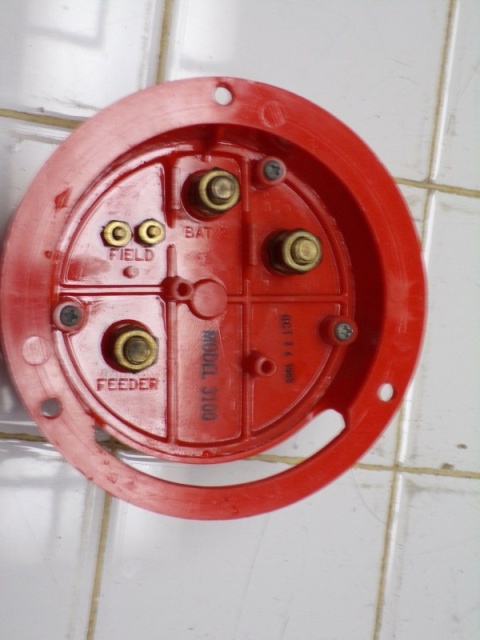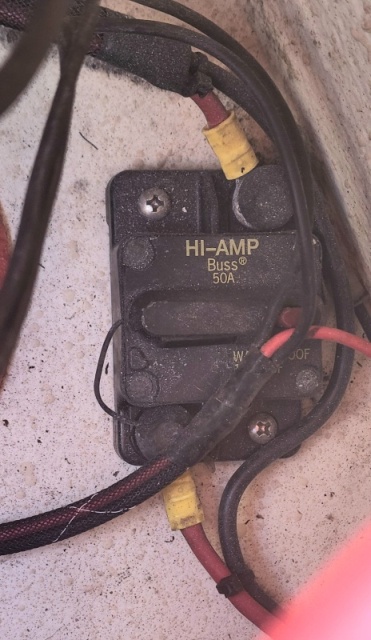| View previous topic :: View next topic |
| Author |
Message |
mutski
Joined: 16 Apr 2022
Posts: 74
City/Region: Homer
State or Province: AK
C-Dory Year: 2005
C-Dory Model: 22 Cruiser
Vessel Name: Just Us
Photos: Just Us
|
 Posted: Tue Sep 06, 2022 2:17 am Post subject: Dual battery connections and a tangle of wires Posted: Tue Sep 06, 2022 2:17 am Post subject: Dual battery connections and a tangle of wires |
 |
|
We went to launch our recently acquired 2005 22-Cruiser today, only to find the battery wouldn't start or tilt the 90HP Suzuki outboard. It appears the culprit was a loose nut holding the ground wire from the outboard to the ground post on Battery 1. But trying to figure this out has me wondering how the connections to its dual batteries are configured.
I had been assuming that the Guest 3100 dual battery switch connected either Battery 1 or Battery 2 or both to the motor, but I don't think I ever tried to run the motor from Battery 2 until today. It turns out that I can start or tilt the motor with the battery switch set to 1 or Both, but not with the switch set to 2. Likewise, the VHF radio, depth sounder and the nav lights, bilge pump etc. switched through the panel on the dash work only with the battery switch set to 1 or Both.
Engine gauges on the dash come on with the ignition switch (i.e. the Suzuki key) no matter where the battery switch is set - even set to Off. Bilge pumps, which I though should work with the battery switch Off, work only with switch set to 1 or Both. Despite the dual battery switch, it appears to me that Battery 2 is connected in parallel. I haven't opened the battery switch, but I'm betting both battery + leads are connected to the Bat 1 connection inside. I don't think the Bat 2 connection is used.
The wiring is an impossible tangle, with all the wires and cables from the outboard zip-tied in a bundle in the battery compartment with the electrical wiring for the rest of the boat. However, I cut the zip-ties and got a rough idea how it's organized, as in the following sketch.

Not shown are a bunch of unidentified wires attached straight to the Battery 1 posts. I know the washdown pump is one of these, as is a ground for the through-hull that feeds it. Maybe some go to the Suzuki gauges and ignition?
There appears to be just one red wire from the outboard to the dual battery switch. Does the outboard charge the batteries through this wire as well as taking power to run the starter and tilt motors?
Here is the battery switch:

It looks like a Guest model 3100, in which case, these would be the connections (from an Ebay photo):

I assume the Feed goes to the outboard starter and tilt motors. A smaller red wire (from the Fields posts?) runs from the battery switch (from the Fields posts?) through the High Amp Buss and apparently to the switch panel on the dash for the running and cabin lights, windshield wipers, bilge pumps etc.

Right now, I'm happy just to have the outboard working again. But I'm wondering if I should disconnect the batteries, dismount the dual battery switch and put the two batteries on separate posts, so that I could isolate one or the other, or run on both together. Or is it better to have both batteries connected in series? |
|
| Back to top |
|
 |
thataway
Joined: 02 Nov 2003
Posts: 20803
City/Region: Pensacola
State or Province: FL
C-Dory Year: 2007
C-Dory Model: 25 Cruiser
Vessel Name: thataway
Photos: Thataway
|
 Posted: Tue Sep 06, 2022 4:00 am Post subject: Posted: Tue Sep 06, 2022 4:00 am Post subject: |
 |
|
Blue type means a link to another site. Click on these for more information.
First, Do you have a digital VOM meter? If not you need to purchase one and learn how to use it.
Second, if the two 12 volt batteries were in series, then the voltage out would be 24 volts (actually about 25.4 volts, resting state.
What is the resting voltage of battery #2? With what you describe, battery #2 is not functional. (It might have a surface charge or even having. a battery charger connected giving a false reading--and when a load is placed on it, there is not enough power to run any components.
With the switch on "all" the two batteries should be connected in parallel. At switch position #1, there should be only the #1 battery connected to any loads, same for position #2, only number 2 battery is going to be connected to any loads.
Generally only the engine charge/output should be connected to the battery post. (An exception is the main bilge pump, and C Dory has often connected the Wallas stove to a battery terminal.)
The "field" is to prevent the diodes in an alternator from burning out when switching batteries, and there being no load. Modern switches have "Make before Break" and do not require connection to field current. I am not even sure if it is possible to use the "field" terminals in your outboard. If indeed you have this same switch, rather than a more modern one, it should be changed out....A boat built in 2005 should have the proper switch.
Actually I prefer that the engine is connected via the start battery to a Voltage Sensitive Relay,(VSR) also known as a Automatic Charging Relay (ACR). Stick with Blue Seas or BEP brands. There are cheaper ones but this is an important piece of kit, and needs to be of quality.
ABYC requires that the output from the switch or battery be fused within 7" of the battery (That is what the 50 amp breaker is for--the engine is not included in this breaker.)
You may want to pick up a copy of the Boater's 12 Volt Bible, or one of the other books which are reviewed on this site.. Also read as many of the "lessons" from Blue Seas. Another good site to follow is Panbo
I like to have a terminal strip (all terminals must be covered after hooked up to prevent a short) right after the afore mentioned circuit breaker. All of the circuits, which are currently on a battery posts (exception may be the bilge pump.) taken off from this terminal strip. (including the console).
There is a lot more to boat wiring. Do some homework, and then sort out the electrical system. I like to label each wire, at both ends when checking out the circuits.
In this case, most likely the #2 battery needs to be load tested, even if it has 12.6 to 12.8 volts at rest. You will also want to check the battery charger to be sure it is working properly.
I say to learn about your boat--so you can fix it on the water, anywhere, and more specifically in AK--where you are more likely to be in a situation where there is no help available.
another web site you need to study is How To;compass marine. There is excellent information (although I don't agree with a couple of issues), and information on tools, and procedures.
I always want a battery status monitor on a boat--and there is either the "Smart shunt" to a smart phone, or the 702/712 Victron meter. (I have also been using a Chinese knock off, for a fraction of the price, just to see how well it works).
In general, you do not want to drain a FLA battery to less than 12.2 volts resting state--this is about 50% discharged. IF the batteries are over 3 years old, I would seriously consider replacing them. Also you are coming up on winter, and must consider storage of the batteries. If the boat is kept in a warm garage or shelter--then not necessary. If left out, even with a cover--the batteries need to be in a warm place and periodically charged. There are some chargers which can be left on--but that is a subject for another day.
_________________
Bob Austin
Thataway
Thataway (Ex Seaweed) 2007 25 C Dory May 2018 to Oct. 2021
Thisaway 2006 22' CDory November 2011 to May 2018
Caracal 18 140 Suzuki 2007 to present
Thataway TomCat 255 150 Suzukis June 2006 thru August 2011
C Pelican; 1992, 22 Cruiser, 2002 thru 2006
Frequent Sea; 2003 C D 25, 2007 thru 2009
KA6PKB
Home port: Pensacola FL |
|
| Back to top |
|
 |
mutski
Joined: 16 Apr 2022
Posts: 74
City/Region: Homer
State or Province: AK
C-Dory Year: 2005
C-Dory Model: 22 Cruiser
Vessel Name: Just Us
Photos: Just Us
|
 Posted: Tue Sep 06, 2022 1:23 pm Post subject: Posted: Tue Sep 06, 2022 1:23 pm Post subject: |
 |
|
Ack, I misspoke. I think the two batteries are wired in parallel. That is the negative posts are tied together, and I think the positive posts both go to Bat 1 in the Guest switch. I guess I'm going to have to pull out the Guest switch to confirm.
I don't understand how the alternator charges the batteries. There is only one wire from the outboard to the Guest switch. Does this both provide battery power to the starter motor and send alternator power to charge the batteries? The only other possibility I see is that a separate alternator wire connects directly to Battery 1 and charges both batteries.
None of the wires are labeled, and most are hidden in identical braided jackets making them extremely difficult to trace. I feel like I should rewire the boat to understand it, but I have no covered space to do that. Frustrating! |
|
| Back to top |
|
 |
mutski
Joined: 16 Apr 2022
Posts: 74
City/Region: Homer
State or Province: AK
C-Dory Year: 2005
C-Dory Model: 22 Cruiser
Vessel Name: Just Us
Photos: Just Us
|
 Posted: Tue Sep 06, 2022 1:55 pm Post subject: Posted: Tue Sep 06, 2022 1:55 pm Post subject: |
 |
|
Well, this is embarrassing. I tightened the cable connections to Battery 2, and now the Guest switch works as expected. If I remove the leads from Bat 2, there is no voltage across them with the switch set to 1, 12.6 V with the switch set to Both and no voltage with the switch set to 2. If I reconnect the cables to Bat 2, the motor starts with the switch set to 2. This makes me feel better.
I am still wondering about the alternator connection. |
|
| Back to top |
|
 |
thataway
Joined: 02 Nov 2003
Posts: 20803
City/Region: Pensacola
State or Province: FL
C-Dory Year: 2007
C-Dory Model: 25 Cruiser
Vessel Name: thataway
Photos: Thataway
|
 Posted: Tue Sep 06, 2022 2:02 pm Post subject: Posted: Tue Sep 06, 2022 2:02 pm Post subject: |
 |
|
| mutski wrote: | Ack, I misspoke. I think the two batteries are wired in parallel. That is the negative posts are tied together, and I think the positive posts both go to Bat 1 in the Guest switch. I guess I'm going to have to pull out the Guest switch to confirm.
I don't understand how the alternator charges the batteries. There is only one wire from the outboard to the Guest switch. Does this both provide battery power to the starter motor and send alternator power to charge the batteries? The only other possibility I see is that a separate alternator wire connects directly to Battery 1 and charges both batteries.
None of the wires are labeled, and most are hidden in identical braided jackets making them extremely difficult to trace. I feel like I should rewire the boat to understand it, but I have no covered space to do that. Frustrating! |
Yes, you need to pull this switch and find out what is going on. It is also possible that the switch is bad. Irregardless, you need to determine the start of charge of the #2 battery. Also follow up on the VSR and monitor for battery status.
There will be a positive and ground to the outboard (Plus the bundle going to the ignition switch, which controls, start solenoid, tilt, trim. and "off".)
The outboard charges which ever battery is connected to the positive wire from the alternator (charging device) on the outboards--this is usually the same wire as goes to the starter. It is possible that the motor hot wire is to the terminal on the battery switch. There is a second charging circuit on some of the newer motors. You would have to check the manual on your engine to see if it has this feature. If it does, then you don't need the VSR. The second charging circuit would go to the #2 battery.
There are several ways to trace wiring--one is a signal generator-which is what I use for trouble shooting. The "make or break' method is to disconnect a wire, and see what does not work!
Yes the wires will all be bundled. Most likely extra wires have been added. Some boats have color code. But, be advised that in that era C Dory would often change color of the wire in its run if not long enough, and seemingly just pick any size or color they had handy. (And that is where some of the issues occurred.)
Before rewiring, you want to draw out the circuits in the boat. If there is no corrosion on terminals or wires, then no real reason to rewire. I had a 20 year old boat which spent its first 10 years in charter service in the Caribbean. I had to completely re-wire that boat, because of corrosion in the wires as traced back from the terminals.
Many of these questions can be answered in the links I gave you above. For example the proper use of the 1/2/all/off battery switch on the Compass Marine how to site.
A tone generator, can be used on non energized wire circuits. They run from $19 to over $2,000. Fluke has a good one in the $120 range, and Klein in the $60 to $70 range.
When replacing wires, always use marine grade, tinned, wire. Also with the crimp fittings you want adhesive heat shrink tubing either built in--or use the adhesive heat shrink tubing over the terminal crimp. A good crimper is a basic tool --see the compass marine site for recommendations. There are lots of videos on the internet to learn to use these various instruments. |
|
| Back to top |
|
 |
ssobol
Joined: 27 Oct 2012
Posts: 3370
City/Region: SW Michigan
State or Province: MI
C-Dory Year: 2008
C-Dory Model: 22 Cruiser
Vessel Name: SoBELLE
Photos: SoBelle
|
 Posted: Tue Sep 06, 2022 2:09 pm Post subject: Posted: Tue Sep 06, 2022 2:09 pm Post subject: |
 |
|
| mutski wrote: | | ... I am still wondering about the alternator connection. |
My boat has a 1-2-Both switch. When set to "1" or "2" only one battery is in the circuit. The alternator will charge the in circuit battery. To charge both batteries at the same time from the alternator, the switch needs to be in "Both".
My battery charger will charge each battery separately via dual channels with the switch in any position. It is recommended not to charge the batteries with the switch in the "Both" position. Since both batteries are connected in this position, it can fool the charger re: battery state sensing. |
|
| Back to top |
|
 |
thataway
Joined: 02 Nov 2003
Posts: 20803
City/Region: Pensacola
State or Province: FL
C-Dory Year: 2007
C-Dory Model: 25 Cruiser
Vessel Name: thataway
Photos: Thataway
|
 Posted: Tue Sep 06, 2022 10:18 pm Post subject: Posted: Tue Sep 06, 2022 10:18 pm Post subject: |
 |
|
I was. in an Ace hardware this $70. I also saw a Fluke 3000 on Amazon for about $90.
We still need to know the voltage of the #2 battery, with switch in "off" position.
The other problem with charging both batteries on "both" when running the engine, is that often folks forget to go to #2 (house) for the night, and then leave lights etc on, and in the AM, both batteries are low. The VSR gets around this issue.
Also the "factory" battery charger is not the best--there are others which which are better, and easier on the battery. Even could be left on during the winter--but best to take the batteries out of the boat, and keep in a warm place. Check voltage every month or so, and put a charger on for a few hours if necessary. |
|
| Back to top |
|
 |
thataway
Joined: 02 Nov 2003
Posts: 20803
City/Region: Pensacola
State or Province: FL
C-Dory Year: 2007
C-Dory Model: 25 Cruiser
Vessel Name: thataway
Photos: Thataway
|
 Posted: Wed Sep 07, 2022 11:23 am Post subject: Posted: Wed Sep 07, 2022 11:23 am Post subject: |
 |
|
correction to the above post: At Ace hardware was a Klein signal generator and tracer for about $70. It seemed like a decent build. Any signal generator must be used on a non energized wire. If an energized wire is used, it will damage the signal generator.
As you look at all connections, check for corrosion--both on the negative and positive side of wiring. Check all terminals, which means undoing the wire, using a soft wire brush (Brass or fine wire SS. Not steel.) and then put a corrosion resistant spray or dielectric grease on the contact surfaces.
A corroded ground may make a battery seem "dead" . This is why it is essential to measure the voltage of batteries directly at the terminals. |
|
| Back to top |
|
 |
|
|
You cannot post new topics in this forum
You cannot reply to topics in this forum
You cannot edit your posts in this forum
You cannot delete your posts in this forum
You cannot vote in polls in this forum
You cannot attach files in this forum
You cannot download files in this forum
|
|

 Search
Search Private Messages
Private Messages Profile
Profile Log in
Log in Register
Register Help
Help




